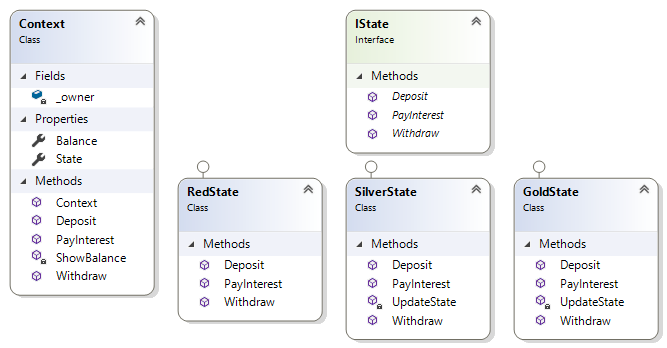State Pattern
Description:
» The State pattern responds to object changes and can change its behaviour by switching to a different set of operations;» The State pattern can be seen as a dynamic version of the Strategy pattern.
Use When:
» You have objects that will change their behaviour at runtime, based on some context;» You have objects that will become complex, with many conditional branches.
//Define the Pattern Interface and Handler Objects.
//Define the IState interface to be used as the "blueprint" for the main State classes.
public interface IState
{
void Deposit(Context context, double amount);
bool Withdraw(Context context, double amount);
bool PayInterest(Context context);
}
//The RedState class (object) represents one particular state.
public class RedState : IState
{
public void Deposit(Context context, double amount)
{
context.Balance += amount;
if (context.Balance > 0)
{
context.State = new SilverState();
}
}
public bool Withdraw(Context context, double amount)
{
context.Balance -= 15.00;
Console.WriteLine("No funds available for withdrawal!\n");
return (false);
}
public bool PayInterest(Context context)
{
Console.WriteLine("No interest paid!\n");
return (false);
}
}
//The SilverState class (object) represents another available state, and is able to update the State object as required.
public class SilverState : IState
{
public void Deposit(Context context, double amount)
{
context.Balance += amount;
UpdateState(context);
}
public bool Withdraw(Context context, double amount)
{
context.Balance -= amount;
UpdateState(context);
return (true);
}
public bool PayInterest(Context context)
{
Console.WriteLine("No interest paid!\n");
return (false);
}
private void UpdateState(Context context)
{
if (context.Balance < 0)
{
context.State = new RedState();
}
else if (context.Balance > 1000)
{
context.State = new GoldState();
}
}
}
//The GoldState class (object) represents another available state, and is able to update the State object as required.
public class GoldState : IState
{
public void Deposit(Context context, double amount)
{
context.Balance += amount;
UpdateState(context);
}
public bool Withdraw(Context context, double amount)
{
context.Balance -= amount;
UpdateState(context);
return (true);
}
public bool PayInterest(Context context)
{
context.Balance *= 1.05;
UpdateState(context);
return (true);
}
private void UpdateState(Context context)
{
if (context.Balance < 0)
{
context.State = new RedState();
}
else if (context.Balance < 1000)
{
context.State = new SilverState();
}
}
}
//Define the IState interface to be used as the "blueprint" for the main State classes.
public interface IState
{
void Deposit(Context context, double amount);
bool Withdraw(Context context, double amount);
bool PayInterest(Context context);
}
//The RedState class (object) represents one particular state.
public class RedState : IState
{
public void Deposit(Context context, double amount)
{
context.Balance += amount;
if (context.Balance > 0)
{
context.State = new SilverState();
}
}
public bool Withdraw(Context context, double amount)
{
context.Balance -= 15.00;
Console.WriteLine("No funds available for withdrawal!\n");
return (false);
}
public bool PayInterest(Context context)
{
Console.WriteLine("No interest paid!\n");
return (false);
}
}
//The SilverState class (object) represents another available state, and is able to update the State object as required.
public class SilverState : IState
{
public void Deposit(Context context, double amount)
{
context.Balance += amount;
UpdateState(context);
}
public bool Withdraw(Context context, double amount)
{
context.Balance -= amount;
UpdateState(context);
return (true);
}
public bool PayInterest(Context context)
{
Console.WriteLine("No interest paid!\n");
return (false);
}
private void UpdateState(Context context)
{
if (context.Balance < 0)
{
context.State = new RedState();
}
else if (context.Balance > 1000)
{
context.State = new GoldState();
}
}
}
//The GoldState class (object) represents another available state, and is able to update the State object as required.
public class GoldState : IState
{
public void Deposit(Context context, double amount)
{
context.Balance += amount;
UpdateState(context);
}
public bool Withdraw(Context context, double amount)
{
context.Balance -= amount;
UpdateState(context);
return (true);
}
public bool PayInterest(Context context)
{
context.Balance *= 1.05;
UpdateState(context);
return (true);
}
private void UpdateState(Context context)
{
if (context.Balance < 0)
{
context.State = new RedState();
}
else if (context.Balance < 1000)
{
context.State = new SilverState();
}
}
}

//Define the Context Object.
//The Context class (object) initialises the State object and invokes methods on the State class (object).
public class Context
{
public IState State { get; set; }
public double Balance { get; set; }
private string _owner;
public Context(string owner)
{
_owner = owner;
State = new SilverState();
}
public void Deposit(double amount)
{
State.Deposit(this, amount);
Console.WriteLine("{0} deposited {1}", _owner, amount);
ShowBalance();
}
public void Withdraw(double amount)
{
if (State.Withdraw(this, amount))
{
Console.WriteLine("{0} withdrew {1}", _owner, amount);
}
else
{
Console.WriteLine("\t15% charge applied for {0}", _owner);
}
ShowBalance();
}
public void PayInterest()
{
if (State.PayInterest(this))
{
ConsoleConsole.WriteLine("Interest paid for {0}", _owner);
ShowBalance();
}
}
private void ShowBalance()
{
Console.WriteLine("\tBalance for {0}": {1}", _owner, Balance);
Console.WriteLine("\tStatus for {0}": {1}\n", _owner, State.GetType().Name);
}
}
//The Context class (object) initialises the State object and invokes methods on the State class (object).
public class Context
{
public IState State { get; set; }
public double Balance { get; set; }
private string _owner;
public Context(string owner)
{
_owner = owner;
State = new SilverState();
}
public void Deposit(double amount)
{
State.Deposit(this, amount);
Console.WriteLine("{0} deposited {1}", _owner, amount);
ShowBalance();
}
public void Withdraw(double amount)
{
if (State.Withdraw(this, amount))
{
Console.WriteLine("{0} withdrew {1}", _owner, amount);
}
else
{
Console.WriteLine("\t15% charge applied for {0}", _owner);
}
ShowBalance();
}
public void PayInterest()
{
if (State.PayInterest(this))
{
ConsoleConsole.WriteLine("Interest paid for {0}", _owner);
ShowBalance();
}
}
private void ShowBalance()
{
Console.WriteLine("\tBalance for {0}": {1}", _owner, Balance);
Console.WriteLine("\tStatus for {0}": {1}\n", _owner, State.GetType().Name);
}
}